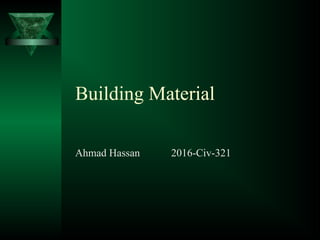
building material in Civil engineering
- 1. Building Material Ahmad Hassan 2016-Civ-321
- 2. Building Material Concrete is a mixture of stone particles, some suitable binding material and water. While in fresh state, concrete is plastic or fluid-like and may be molded in any shape but, with time, it hardens and becomes an artificial stone-line material. Because small stone particles may be “assembled” at site to provide any desired architectural shape and because of the relatively lesser cost, concrete is used for most of the construction. The main constituents of concrete are described below: Concrete
- 3. It is usually a paste of cement in water and is the relatively costly constituent of the concrete. Lime and some other materials may also be used as binding material. Binding Material It is required to reduce the cost and, at the same time, to provide sufficient strength. Most commonly. Filler material is composed of natural round gravel or crushed stone but other materials like brick-ballast, bloated clay and iron chips may also be used in certain cases. Filler material may also be termed as “Aggregate”. Filler Material
- 5. Within a particular aggregate, particles of all the sizes must be present in a suitable proportion. In other words, the size of aggregate particles should gradually reduce to minimum so that the smaller particles may fill spaces between the larger particles to give a dense mass. It is quite clear that the larger particles must be present in greater proportion. Depending upon the particle size, the aggregates may be classified into two categories, coarse and Find Aggregates. The portion of aggregate having particle size greater than 3/16- in (4.75 mm) is called Coarse Aggregate while the portion having particle size lesser than or equal TO 4.75 mm is called Fine Aggregate (or Sand) Filler Material
- 6. There are two main types of concrete to be used for construction purposes namely: Plain Cement Concrete Reinforced Cement Concrete. Concrete It is abbreviated as P.C.C. and is the simple concrete without the provision of embedded steel bars (or reinforcement). Ratio of the constituent materials is also written with a particular P.C.C to be used in the following standard way: For example, P.C.C. (1:2:4) means that cement content by weight is one out of 7 parts, sand is 2 out of 7 parts and coarse aggregate is 4 out of 7 parts. Plain Cement Concrete
- 7. It the cement content is concrete is lesser than about 10% , the concrete is called lean concrete and is commonly used under the floors and foundations. P.C.C. (1:4 8) and P.C.C. (1:6:12) are the examples of lean concrete. Lean Concrete It the cement content is 10 to 15%, the concrete is called normal concrete, the example being P.C.C. (1:2:4). Normal concrete is used in D.P.C., R.C.C. and floor finishes. Normal Concrete In rich concrete, the cement content is more than about 15% as in P.C.C. (1:1.5:3). It is used for support heavier loads for architectural reasons. Rich Concrete
- 8. It is abbreviated as R.C.C. and is defined as the concrete with the addition of steel bars or reinforcement to resist tension. R.C.C. is used for beams, lintels, roof-slabs and concrete columns, etc. Reinforced Cement Concrete Mortar is a material used for plastering of walls and roofs and to join bricks in masonry. Mud mortar and lime mortar were initially used but now-a-days cement sand mortar is most commonly used abbreviated as C/S mortar. Its constituents are cement and sand and the ratio of these materials is also specified. For Example, (1:2) C/S mortar means that cement is one part out of three by weight and sand is two parts out of three by weight Mortar
- 9. It is abbreviated as R.C.C. and is defined as the concrete with the addition of steel bars or reinforcement to resist tension. R.C.C. is used for beams, lintels, roof-slabs and concrete columns, etc. Reinforced Cement Concrete Mortar is a material used for plastering of walls and roofs and to join bricks in masonry. Mud mortar and lime mortar were initially used but now-a-days cement sand mortar is most commonly used abbreviated as C/S mortar. Its constituents are cement and sand and the ratio of these materials is also specified. For Example, (1:2) C/S mortar means that cement is one part out of three by weight and sand is two parts out of three by weight Mortar
- 10. It is abbreviated as R.C.C. and is defined as the concrete with the addition of steel bars or reinforcement to resist tension. R.C.C. is used for beams, lintels, roof-slabs and concrete columns, etc. Reinforced Cement Concrete Mortar is a material used for plastering of walls and roofs and to join bricks in masonry. Mud mortar and lime mortar were initially used but now-a-days cement sand mortar is most commonly used abbreviated as C/S mortar. Its constituents are cement and sand and the ratio of these materials is also specified. For Example, (1:2) C/S mortar means that cement is one part out of three by weight and sand is two parts out of three by weight Mortar